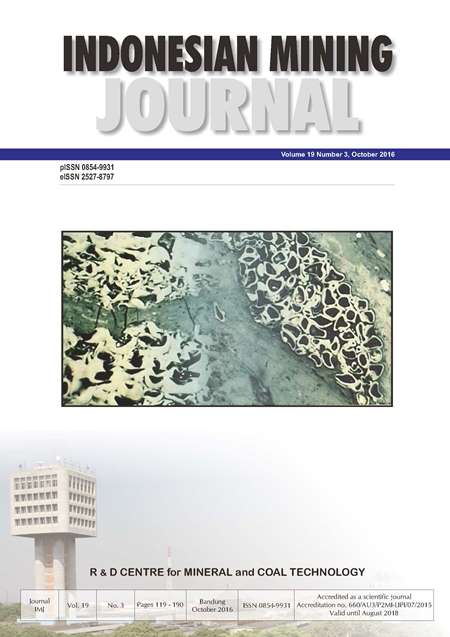BIOLEACHING OF LOW GRADE NICKEL ORE USING INDIGENOUS FUNGI
DOI:
https://doi.org/10.30556/imj.Vol19.No3.2016.540Keywords:
bioleaching, low grade nickel ore, indigenous fungi, Aspergillus sp, Penicillium spAbstract
In this research, the biological leaching of nickel by indigenous fungi isolated from Indonesian limonite was studied to develop a feasible technique for microbial recovery of nickel from low grade nickel ore. XRD analyses indicated that goethite, alumina and quartz were major mineral composition of the ore. In the present study, isolated fungal strains having potential to solubilize nickel were characterized. that were identified as Aspergillus sp and Penicillium sp depending upon their colony morphology and microscopic studies. All microorganisms found were tested for organic acid production and leaching capabilities of nickel. Leaching experiments were performed in 250 ml Erlenmeyer flask at room temperature and 150 rpm agitation under aseptic conditions. It was observed that the Aspergillus sp substantially leached more nickel from limonite compared to the Penicillium sp. Nickel solubilization was related to pH decrease and organic acid excreted caused by growth of fungi in medium containing glucose as carbon source. The mechanisms of nickel extraction had been examined either directly or indirectly related to fungal activity. The presence of fungal cells seems to improve the leaching process. However, the use of higher pulp density resulted in a decrease of nickel solubilization. The maximum nickel recovery was 57% at 5% pulp density after 20 days of direct leaching by Aspergillus sp.References
Addo, M. G., Kusi, A., Andoh, L. A. and Obiri-Danso, K. (2016) “Citric acid production by Aspergillus niger on a corn cob solid substrate using one-factor-at-a-time optimisation method,” IARJSET, 3(1), pp. 95–99. doi: 10.17148/IARJSET.2016.3120.
Ahmadi, A., Khezri, M., Abdollahzadeh, A. A. and Askari, M. (2015) “Bioleaching of copper, nickel and cobalt from the low grade sulfidic tailing of Golgohar Iron Mine, Iran,” Hydrometallurgy, 154, pp. 1–8. doi: 10.1016/j.hydromet.2015.03.006.
Ali, S. R., Anwar, Z., Irshad, M., Mukhtar, S. and Warraich, N. T. (2016) “Bio-synthesis of citric acid from single and co-culture-based fermentation technology using agro-wastes,” Journal of Radiation Research and Applied Sciences, 9(1), pp. 57–62. doi: 10.1016/j.jrras.2015.09.003.
Ashcroft, G. (2016) Nickel laterites: The world largest source of nickel, Geology for Investors. Available at: http://www.geologyforinvestors.com/nickel-laterites/.
Audenaerde, V. (2013) An extraction sustainable nickel from olivine via carbonation and bioleaching treatments. KU Leuven, Belgium.
Bazgha, A., Haq, N. B. and Sadia, I. (2011) “Bio-extraction of metal ions from laterite ore by Penicillium chrysogenum,” African Journal of Biotechnology, 10(54), pp. 11196–11205. doi: 10.5897/AJB11.1296.
Behera, S. K., Sukla, L. B. and Mishra, B. K. (2010) “Leaching of nickel laterite using fungus mediated organic acid and synthetic organic acid: A comparative study,” in Proceedings of the XI International Seminar on Mineral Processing Technology, pp. 946–954.
Biswas, S., Dey, R., Mukherjee, S. and Banerjee, P. C. (2013) “Bioleaching of nickel and cobalt from lateritic chromite overburden using the culture filtrate of Aspergillus niger,” Applied Biochemistry and Biotechnology, 170(7), pp. 1547–1559. doi: 10.1007/s12010-013-0289-9.
Blevich (2015) The Indonesian nickel industry - Strategic market prospects out to 2020. Metal Bulletin Research.
Bohidar, S., Mohapatra, S. and Sukla, L. B. (2009) “Nickel recovery from chromite overburden of Sukinda using fungal strains,” International Journal of Integrative Biology, 5(2), pp. 103–107.
Chiang, Y. W., Santos, R. M. Dos, Van Audenaerde, A., Monballiu, A., Van Gerven, T. and Meesschaert, B. (2014) “Chemoorganotrophic Bioleaching of Olivine for Nickel Recovery,” Minerals, 4(2), pp. 553–564. doi: 10.3390/min4020553.
Coto, O., Cabrera, G., Hernadez, I., Cantero, D. and Gomez, J. M. (2016) Bioleaching of laterite tailings by strains of Aspergillus niger. University of Havana.
Ghosh, S. and Paul, A. K. (2016) “Bioleaching of nickel by Aspergillus humicola SKP102 isolated from Indian lateritic overburden,” Journal of Sustainable Mining, 15(3), pp. 108–114. doi: 10.1016/j.jsm.2016.11.002.
GLENCORE (2016) Nickel market development; Present : Improved market condition.
Kuck, P. H. (2015) Nickel. US Geological Survey.
Mubarok, M. Z., Astuti, W. and Chaerun, S. K. (2012) “Leaching behaviour of nickel from Indonesian laterite ore in some organic acids,” in Proceedings of XIII International Mineral Processing Symposium (IMPS 2012), pp. 523–531.
Simate, G. S., Ndlovu, S. and Walubita, L. F. (2010) “The fungal and chemolithotrophic leaching of nickel laterites — Challenges and opportunities,” Hydrometallurgy, 103(1–4), pp. 150–157. doi: 10.1016/j.hydromet.2010.03.012.
Singh, P., Draboo, S., Singh, A., Chaturvedi, S., Sharma, S. and Verma, P. (2016) “Citric acid production from different sources under submerged conditions using Aspergillus niger,” International Journal of Current Microbiology and Applied Sciences, 5(5), pp. 483–492. doi: 10.20546/ijcmas.2016.505.050.
Watling, H. (2016) “Microbiological Advances in Biohydrometallurgy,” Minerals, 6(2), p. 49. doi: 10.3390/min6020049.
Widajatno, D. (2011) “The Indonesian mineral mining sector: Prospects and challenges,” in German-Indonesia Mining Technology Symposium. Jakarta, pp. 1–42.
Downloads
Published
Issue
Section
License
Indonesian Mining Journal provides immediate open access to its content on the principle that making research freely available to the public to supports a greater global exchange of knowledge.

This work is licensed under a Creative Commons Attribution-NonCommercial 4.0 International License.













